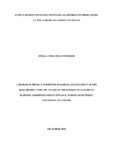| dc.description.abstract | Managers in every firm are faced with challenges making decisions on three important aspects of the organizations. The first decision that should be considered by the management is the financing decision, then the investing decision and finally the operating decision. These decisions enable a company to achieve an optimal position in maximizing the shareholder’s wealth. It therefore becomes imperative for an organization to have an optimal structure of capital that determines the level of debt financing that would propel it closer to its goals. The realization that capital structure decisions influence the value of a firm, sensitizes the management to try achieve the optimal capital structure that exploits the value of the shares of the company. However, the attainment of this objective exposes most firms to financial distress which arises as a result of debt financing beyond a certain capacity that makes it difficult for the company to achieve its short term and long-term duties as and when they fall due. This study therefore focused on determining the effect of debt financing on financial distress for listed firms at the Nairobi Securities Exchange in Kenya. The study involved the use of descriptive research design as the research methodology, where secondary data collection methods were employed to obtain data from audited published financial statements of these firms for the period 2013 to 2017. A response rate of 24 companies out of 37 non - financial firms listed at NSE had full information for all the six independent variables that were made up of liquidity ratio, leverage, productivity ratio, solvency ratio, Asset utilization ratio and firm size, which represented a 64% response rate. Financial distress for the firms was obtained by Altman’s Z score which suggests that a score of below 1.8 shows that the firm would be distressed. A score of 3 shows high chances of distress for the company while above 3 is considered to be a stable firm. The mean score for all the firms was 12.95 that showed that in average the firms listed at NSE were stable. However, several firms were below the threshold requirement of the score at 1.2 and thereabouts. The multiple linear regression model that was employed showed a coefficient of determination (R squared) value of 58.7% that suggested that the model was able to predict the dependent variable (Financial distress) to the level of 58.7%. The F statistic from ANOVA table was above the F critical value that led to rejection of the null hypothesis. The alpha value of 0.000 was less than 0.05 and the study therefore concluded that there was negative significant effect of debt financing to financial distress for these firms. The financial leverage had a negative correlation to financial distress, while liquidity, productivity, solvency and asset utilization had positive correlation towards financial distress. | en_US |



